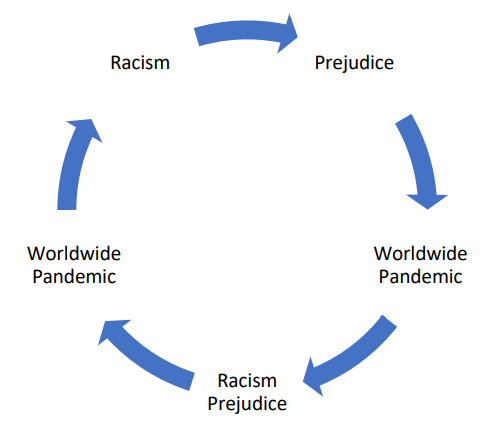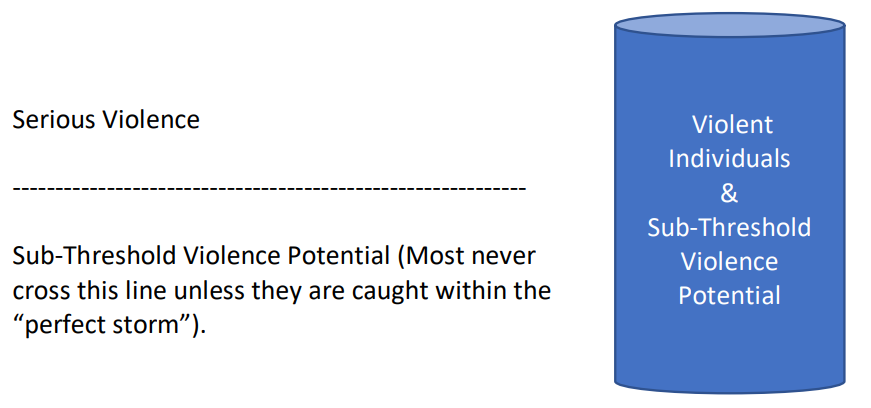EXTENDED CRITICAL PERIOD: Racism, Prejudice and A Worldwide Pandemic

Context:
Since the pandemic reached the shores of North America we have released several E-Alerts that have combined our understanding of how high-profile trauma influences human systems including how it increases violence potential. In the field of Violence Threat Risk Assessment (VTRA™) we have always said that “no one can engage in a major act of violence unless they feel justified: everyone needs to move on a pathway of justification first.” What has not been understood by some leaders and practitioners in violence prevention and public safety is that some individuals, even those with no history of violence, may be highly committed to violence. For some of those individuals it will only be under certain circumstances such as exposed racial trauma and social injustice. In these situations, we say that the “first time” perpetrators risk for violence had simply laid dormant until the right set of circumstances unleased their rage.
We have also consistently said that high-profile trauma like school shootings and other forms of mass violence have demonstrated the existence of what is referred to as the “Trauma-Violence Continuum” (TVC). The TVC simply highlights that serious violence can beget trauma but trauma (in all of its forms) can beget serious violence as well. From a human systems perspective it means that the hypervigilance and hypersensitivity generated from trauma can build to a subthreshold for violence, suicide or a combination of both. But it may only be triggered or crossed into action when a “perfect storm” swirls around them. Some want to blame the storm as the cause, but it is all the trauma, pain and betrayals that got them to that subthreshold line in the first place.

The real issue relevant to those responsible for Crisis and Trauma Response (TES™) and Violence Threat Risk Assessment (VTRA™) is that high-profile violence or high-profile trauma does not does not generally create new “dynamics” in human systems and relationships but instead simply intensifies already existing “dynamics!” The micro application of this is family dynamics that we addressed in “Family Dynamics During the Pandemic: Closeness-Distance Cycle” (Click the Link). The macro application is what we are experiencing right now in North America! Evidence of this is the escalation of media and social media generated violence resulting in other individuals, groups and communities being “primed” to “join the cause”.
The Pandemic is the Foundation for Unleashing Years of Trauma
Racism and prejudice are systemic issues that have been present for generations in North America highlighted by times of extreme stress such as the “Civil Rights Movement” in the 1960’s. Yet many, not burdened under the weight of racism, have felt there has been a relative calm and good enough solutions. What the pandemic has done is profoundly increase the anxiety level of society in general. A standard expression in our VTRA™ and TES™ work is “the higher the anxiety, the greater the symptom development”. Prior to the George Floyd tragedy, anxiety was already spiking with increases in domestic violence, child abuse, etc. due to quarantine and economic downturns. The perfect storm is a worldwide pandemic that has not created new dynamics but simply intensified already existing ones including the plague of racism. To a certain degree, two pandemics have converged (COVID-19 and Racism) overlaid with the many stories of untold trauma of which the situation in Minnesota is now symbolic.
Unfortunately, traumatic exposure can trigger the “fight, flight, freeze” response in individuals but it can do the same thing in entire human systems as well. For example, some families impacted by the effects of racism are fighting, some are fleeing and some are paralyzed by the protests, demonstrations, riots and looting around them. And some will bare guilt for what they did or didn’t do in the aftermath.
Trauma Response Application
Teach – Teach – Teach
There is an opportunity to teach our children and youth from the current crisis, and in the process, “mature-up” a bit ourselves. As professionals, consider your own biases and how you project them in your actions with your own families and those you work with. This is a great time to pivot and recalibrate how we want to proceed as individuals, families, workplaces, communities and nations. As is typical in our systemic approach to violence prevention and trauma response we see a distinction between prejudice and racism and find it more useful to understand it as “a bead on a string”. Prejudice and racism defined:
- Prejudice is when one human being makes judgements about another human being based on information from a single or limited experience (usually negative) with that “type of person”, societal stereotypes of those “type of people” or family-generated attitudes about others. At its lowest severity, prejudice is about discomfort with the other but not a belief they are actually genetically superior to the other.
- Racism is when one human being believes they are genetically superior or divinely superior (religiosity) to a race different from theirs.

Sometimes good people, paralyzed by their prejudices, allows for the generational transmission of fear-related symptoms. Meaning it is easier to manage our own anxieties and fears by just avoiding the “other”. Doing the hard work of considering the actual human condition we are all subject to is perceived as too overwhelming. So, when veiled racists with violent ideation or violence potential occupy seats of power, they often take advantage of those prejudices and puppet the ill-informed. This includes all human systems not just governments where one strategic racist can ignite and magnify the many prejudices around us. Therefore, the second hypothesis in VTRA™, “Conspiracy of Two or More” is essential to guide our efforts in threat assessment during this emotionally heightened and extended critical period.
Violence Threat Risk Assessment (VTRA™) Application
1. Use your Community VTRA™ Protocols for “High-Profile VTRA’s. According to your VTRA™ Community Protocols the combination of the pandemic and the current unrest should result in protocol leaders identifying individuals or groups who may have violence potential for strategic and thoughtful contact that will help mitigate any local escalations. This should include matching the “right” person or agency to make contact that is most likely to lower the anxiety of the Person(s) of Concern (POC).
2. Identify those in need and seek them out: As leaders, identify any members in your communities who may be part of a group recently targeted. In this circumstance, local leaders of systems and subsystems should be reaching out to cultural leaders to offer support in areas they can actually assist. This may be emotional support (“we stand with you”), it may be physical support to protect buildings including homes and places of worship, it may be to assess threats they have received or feel may exist. It may even be to resolve an old conflict we had locally and just left unresolved but is currently preventing those in need of support from either asking or accepting it when offered.
3. Do not avoid offering support because of being rebuffed by one leader. We are all engaged in the human experience and one leader may be traumatically closed and say “we are fine” when many others want help, so be strategic. Find other leaders or coleaders who may be able to bridge the gap and invite us in.
4. Reach out to other groups who have been targeted by hate in the past but are not the focus of the current incident. Many people will have “rekindled trauma” as the current tragedy reminds them of their own past experiences. In this media saturated generation we live in, groups that have been targeted by hate and violence are used to people showing up to help them when the cameras are recording, and the world is watching. But once the media has moved to a new story they are aware of how quickly abandonment can occur. This dynamic alone can generate hurt and anger in some and contribute to the Trauma-Violence Continuum.
5. Genuine support: Violence prevention and traumatic aftermath support are successful when all involved are engaged in ongoing and genuine relationship building.
6. Stay the course of support: Vigils that are represented by culturally diverse groups around the world saying “an attack against you is an attack against us all” are wonderful to see if they are genuine. Even in these contexts, some leaders show up for the cameras and disappear just as quickly when the world is no longer engaged. Our young adults and children watch us and many notice the incongruencies of the adult world around them. Therefore, a theme for every group of religious leaders that have come together, as well as, government leaders, multi-stakeholder leaders and our youth leaders should be: “what are we going to do when the cameras are gone.”
7. Parents and caregivers need to increase their interest in the children and youth in their care. Parents and grandparents of adult children need to increase their interest in their children and grandchildren respectively. The more we interact with children in this current climate the more we are seeing, that with many, their anxiety is very high because of how both micro and macro dynamics are affecting their lives. However, because some adults are not talking to them about the current state of affairs, many are not talking with the adults. There is still this old-fashioned belief that “if my child needs to talk they know I’m here,” when in reality if we don’t take the lead they just learn we are not there. In otherwise well-meaning homes we have empty vessels who are not connected to healthy mature adult supports, and when it becomes apparent to them that they are alone, they take up full time residence in social media.
8. Promote meaningful conversations: Parents/Caregivers and professionals involved with school-aged children should be meeting to have “meaningful conversations” amongst ourselves about our local circumstances and then get organized to engage with our children and youth for meaningful conversations with the goal of more visible connection in each other’s lives.
9. Strategically increase our connection with people of concern: In VTRA we state “
- the more a troubled individual can identify with the aggressors the more it will increase their symptom development
Conclusion
Experience dictates that more people are prejudiced than racist which means that education can be powerful. We have an opportunity to learn and then teach our children and youth and hopefully be open about what we do not know about human beings who seem different from us. The good news is that prejudices can be overcome whereas racism is far more difficult to combat. Hope is essential for our children and youth to maneuver through the trauma of a worldwide pandemic and the uncovering of how deep the roots of prejudices and racism go. Use this opportunity to grow the minds of the rising generation.
Sincerely,
J. Kevin Cameron, M.Sc., R.S.W., B.C.E.T.S., B.C.S.C.R.
Board Certified Expert in Traumatic Stress
Diplomate, American Academy of Experts in Traumatic Stress
Executive Director, North American Center for Threat Assessment and Trauma Response
